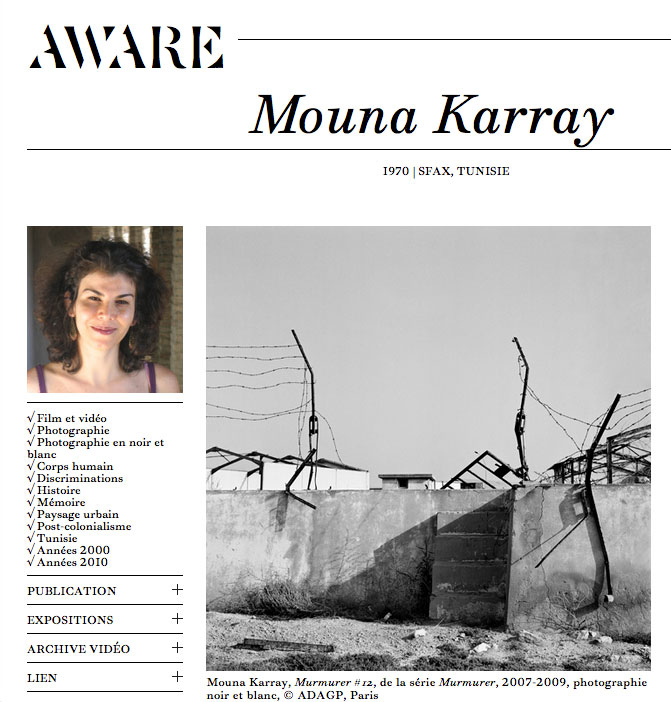Aware - Mouna Karray
Marian Nur GoniArchives of Women Artists, Research and Exhibitions
(…) With an often intimate and poetic tone, her photographic series focus on past or more recent socio-political issues.(…)

Mouna Karray
1970 | SFAX, TUNISIA
Tunisian photographer and video artist.
Mouna Karray is a photographer and video artist who lives and works in Paris and Sfax. She
studied at the Institut supérieur d’animation culturelle in Tunis and at the Tokyo Institute of
Polytechnics and Arts, from which she graduated with a Master’s degree in 2001.
Her work has been shown in solo shows (in Tunisia and Great Britain) and collective exhibitions (The Divine Comedy. Heaven, Hell, Purgatory Revisited by Contemporary African Artists, Frankfurt, Museum für Moderne Kunst / Washington, Smithsonian National Museum of African Art / Savannah, Walter O. Evans Collection of African American Art, 2014; Broken English, London, Tyburn Gallery, 2015; Afriques capitales, Paris, la Villette / Lille, Saint-Sauveur station, 2017; opening exhibition of the Zeitz Museum of Contemporary Art Africa, 2017, etc.), as well as international events (Dakar and Bamako Biennales, Photoquai, les Mois de la photo du Grand Paris). With an often intimate and poetic tone, her photographic series focus on past or more recent socio-political issues.
“The question I ask myself is: how does one tell a story? […] Is History the privilege of rich people, of city dwellers, of winners? How does one tell the story of those who were left on the sidelines of Tunisia’s independence and revolution?” the artist wonders in a discussion with anthropologist Alexandra Galitzine-Loumpet (A*Magazine, June 2017). These questions were the starting point for the series Personne ne parlera de nous (Nobody Will Talk About Us), shot from 2012 to 2015 in the south of Tunisia. In each of the photographs, a strange white bag – from which a body seems to want to break free – is shown sitting amid rocky and often solitary landscapes. Now and again, men, animals and children pass nearby, going about their everyday occupations. But what is the enigmatic presence doing there? And most of all, what does it represent?
While the artist refuses, and rightly so, to provide direct and unequivocal clarifications of her work, instead referring to a “silent and suggestive questioning”, the themes that stand out offer a subtle comment on feelings of isolation, oppression, and suffocation. However, there are also glimpses of hope, resistance, and possible liberation in these pictures: the eight photographs of the series Noir (2013) also show a body wrapped in white fabric; in this case, a hand can be seen slipping out of the wrapping to press the shutter release, in a gesture that perhaps foreshadows the promise of a breath of air or of empowerment. She uses a similar process in the series The Rope (2014), in which a tug of war is stretched out over four successive photographs (with an overexposed portion hiding part of the rope), suggesting both the tension and the balance between the two players pulling at the ends. This same capacity for resistance, no matter how modest or minuscule, also resonates in the series Murmurer (2007–2009), for which the artist returned to the outskirts of her hometown of Sfax to photograph the remains of the wall that used to surround the port that once brought wealth to the city. In this case also, we find ourselves immersed in the margins, in fullness and emptiness, in stories of times past and future, in the layered strata of eras. They are imbued with the implicit question of the evocation of the experiences that happened there – another overarching theme in M. Karray’s work.
Marian Nur Goni
Translated from French by Lucy Pons
